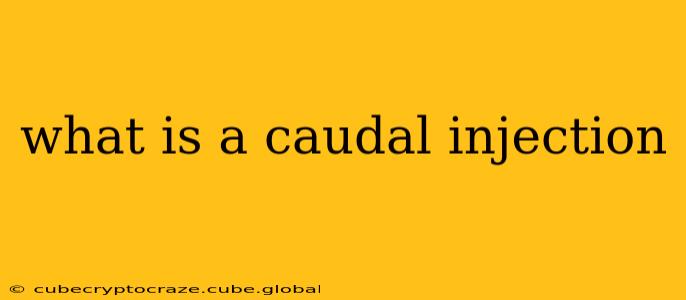A caudal injection is a type of injection administered into the epidural space of the lower back, specifically the caudal canal. This canal is located at the very bottom of the spine, just above the coccyx (tailbone). The procedure involves injecting medication directly into this space, allowing it to spread throughout the lower spinal nerves. This targeted approach makes caudal injections effective for treating various conditions affecting the lower back, pelvis, and legs.
What is the purpose of a caudal injection?
The primary purpose of a caudal injection is to deliver medication to the targeted area for pain relief and/or inflammation reduction. The specific medication used will depend on the condition being treated, but commonly includes steroids (corticosteroids), local anesthetics, and sometimes other medications. The goal is to reduce inflammation and nerve irritation, alleviating pain and improving function.
What conditions are treated with caudal injections?
Caudal injections are commonly used to treat a range of conditions, including:
- Lower back pain: This is a frequent reason for seeking a caudal injection. Pain stemming from spinal stenosis, herniated discs, or other sources can often be effectively managed.
- Sciatica: This nerve pain radiating down the leg, often caused by compression or irritation of the sciatic nerve, may respond well to a caudal injection.
- Coccydynia (tailbone pain): Pain localized to the tailbone, often caused by injury or inflammation, can be targeted directly with a caudal injection.
- Sacroiliac (SI) joint pain: Pain in the joint connecting the sacrum and ilium, often associated with inflammation or instability, can be addressed.
- Post-surgical pain: In some cases, caudal injections may help manage pain following lower back or pelvic surgery.
How is a caudal injection administered?
The procedure is typically performed by a physician specializing in pain management or anesthesiology. It generally involves these steps:
- Preparation: The area is cleaned and sterilized. Local anesthetic may be injected into the skin to numb the injection site.
- Insertion: A small needle is carefully inserted into the caudal canal. Fluoroscopy (a type of real-time X-ray) may be used to guide the needle placement and ensure accurate delivery of the medication.
- Injection: Once properly positioned, the medication is slowly injected into the epidural space.
- Post-procedure: Patients usually remain under observation for a short time after the injection.
What are the risks and side effects of a caudal injection?
While generally considered safe, caudal injections carry potential risks and side effects, including:
- Bleeding or bruising at the injection site.
- Infection at the injection site.
- Dizziness or lightheadedness.
- Headache.
- Nerve damage (rare).
It is crucial to discuss any potential risks with your doctor before undergoing the procedure.
How long does it take to see results from a caudal injection?
The time it takes to experience pain relief varies considerably from person to person. Some patients report immediate relief, while others may see results within a few days or weeks. The duration of pain relief also varies, potentially lasting from a few weeks to several months.
What is the recovery time after a caudal injection?
Recovery time is generally minimal. Most patients can return to their normal activities shortly after the procedure, though strenuous activity may need to be avoided for a short period. Your doctor will provide specific post-procedure instructions.
Are there alternatives to caudal injections?
Yes, several alternative treatments exist for conditions that may benefit from a caudal injection. These may include physical therapy, medication (oral or topical), other types of injections (e.g., facet joint injections), and surgery in severe cases. Your doctor will help determine the most appropriate treatment based on your individual needs and condition.
This information is for general educational purposes only and should not be considered medical advice. Always consult with a healthcare professional for diagnosis and treatment of any medical condition.
